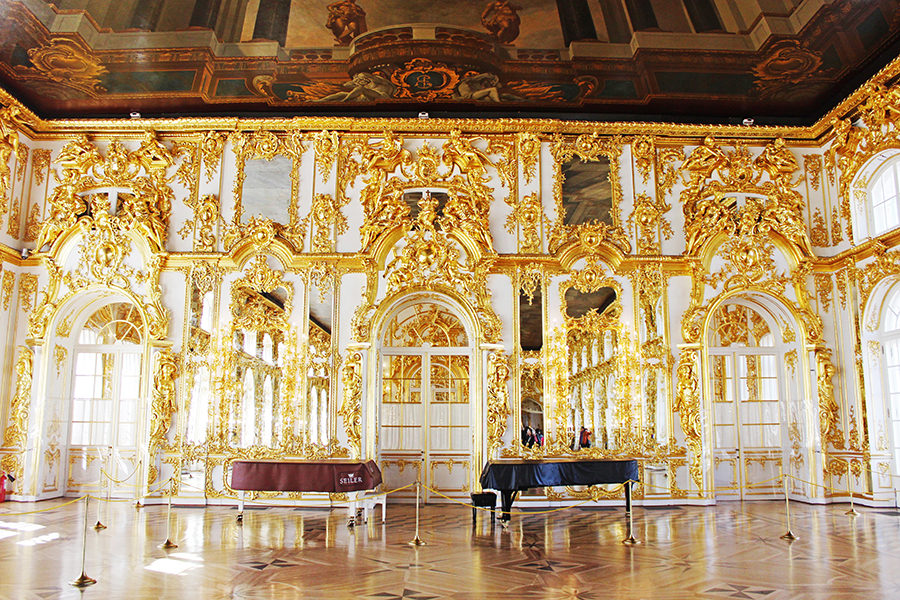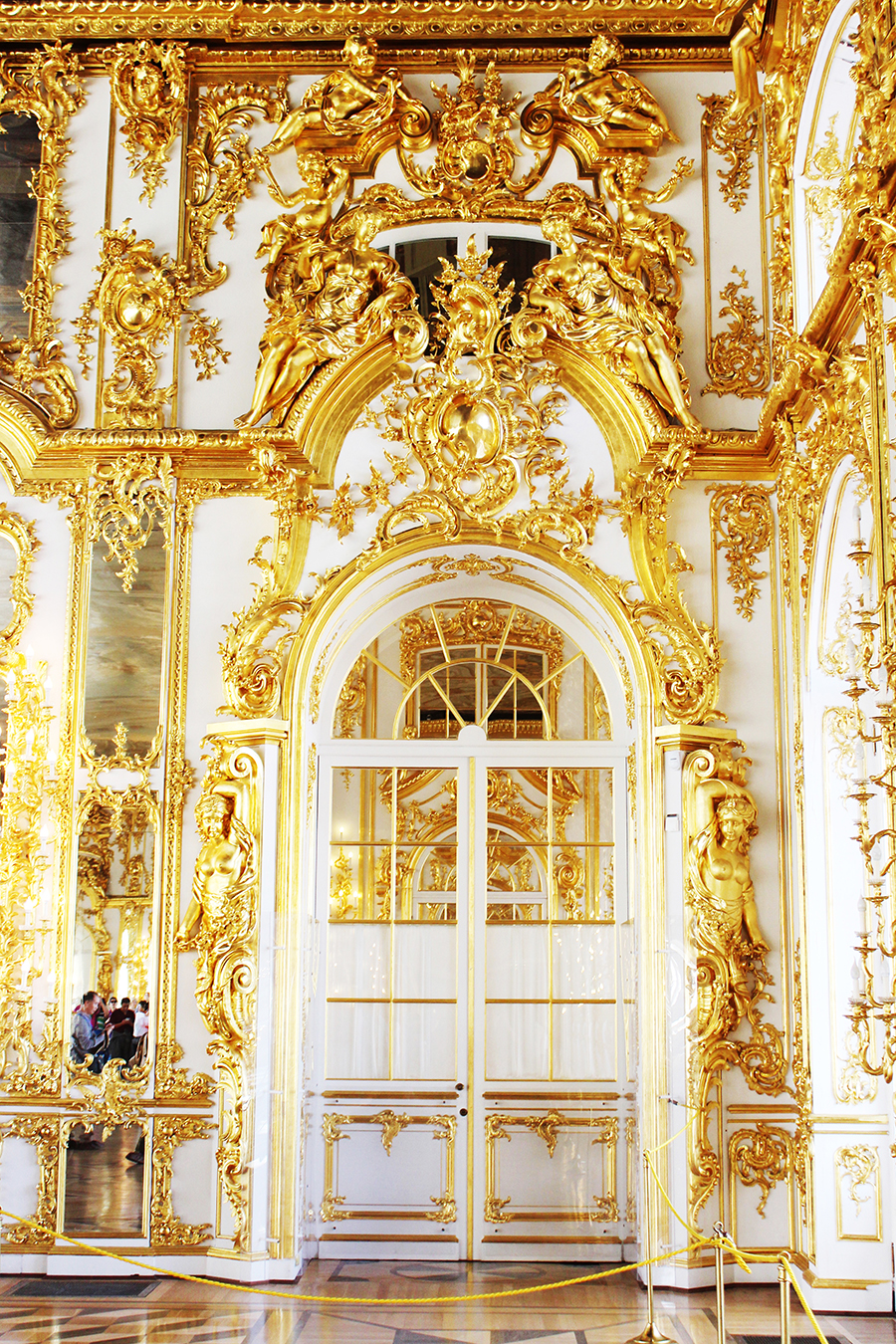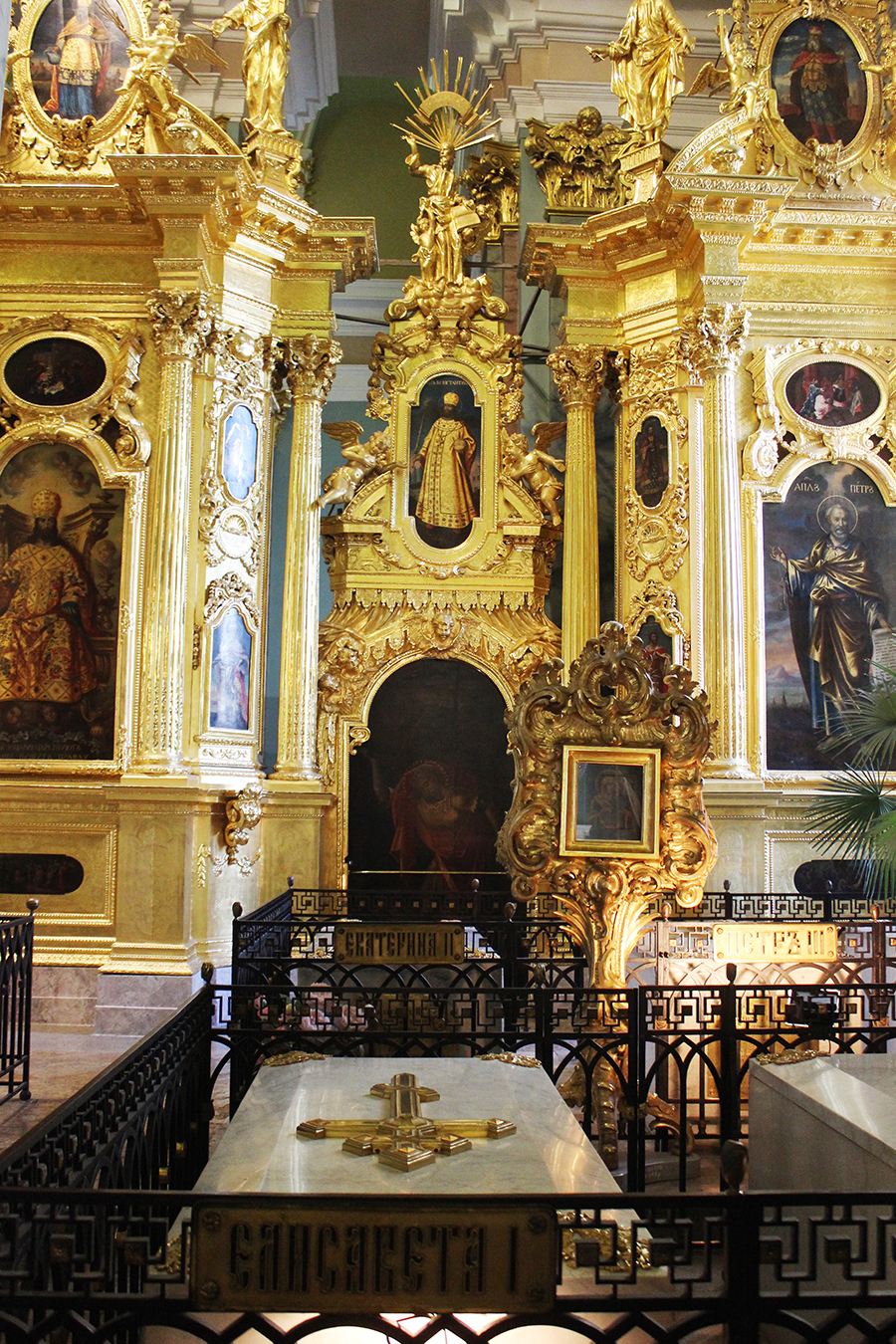
I mentioned in my Moscow blog post that the Russian capital is a juxtaposition of Communist relics and nouveau-riche ostentation. The opposite seems to be true of St Petersburg - the city's contemporaries are decidedly more relaxed, while monuments to decadence and excess are firmly entrenched in history.
The Tsars and Tsarinas of Russia were the original Gs. Their subjects must've felt the same way - fed up of living under the thumb of their social betters, the proletariat revolted. By 1917, the Tsarist autocracy effectively dismantled when Tsar Nicholas II, the last Emperor and Autocrat of All the Russia abdicated. Only a year later, the Tsar and his family (the Romanovs) would meet a bloody end at the hands of the Bolsheviks. Before the tide of revolution washed away the last of the ruling class, the capital was Saint Petersburg (or Petrograd as it was briefly named between 1914 - 1924) - an imperial city whose fabulous palaces and grand cathedrals showcased the might and wealth of the Tsars. It still is, today - St Petersburg feels like a city frozen in a time of Imperial Russia. I arrived in Moscow by way of Sapsan (Russia's answer to Japan's shinkansen - bullet train) and was immediately impressed by how the city seemed eerily untouched by the ravages of modernisation. St Petersburg felt very much like a museum whose hallowed halls are haunted by the spectres of history.

Saint Petersburg cribs: Russian Tsars Edition
CRIB I : PETERHOF PALACE, PETERGOF
Ima take ya back to the beginning - where it all started, at Peterhof Palace in Petergof, Saint Petersburg. Peter the Great, the founding father of St Petersburg built the first capital of Russia from nothing - the city was a desolate swamp pre-1703 before Daddy P created it to be the display of Imperial Russia’s growing status in the world. Peter the Great was said to be obsessed with water - way before so-called 'Tumblr mermaids' made it a thing. The palace grounds' Grand Cascade and Samson Fountain (modelled on one constructed for Louis XIV at his Château de Marly) springs out of a pool leading to the terminus of the fountain-lined Sea Channel where it meets the Baltic Sea.

Especially impressive is how all of the fountains operate without the use of pumps, using only water from natural springs collected in reservoirs in the Upper Gardens. The elevation difference creates the pressure that drives most of the fountains of the Lower Gardens, including the Grand Cascade. The Samson Fountain is supplied by a special aqueduct over four kilometres in length, which draws water and pressure from a high-elevation source to create a magnificent display that visitors today witness from 11 in the morning, accompanied by the fanfare of classical music.


The palace, and its grounds and fountains, as seen from the Sea Channel.

Peterhof was built to celebrate Peter the Great's access to the Baltic, hence the Sea Channel's watery reach from palace to sea.

Peterhof Palace and its gardens, dubbed by some as the 'Russian Versailles' is now recognized as a UNESCO World Heritage Site. The Grand Palace itself is not especially large nor elaborate (compared to other Russian palaces) - apart from his love of impressive water works, Peter the Great's tastes were practically modest by Tsar standards. Peterhof's relatively conservative interiors didn't stop the Nazis from ransacking and looting the place - to this day the palace is undergoing restoration work. A summary of the restoration team's incredible efforts (including a textile artisan who painstakingly recreated a room's silk wallpaper, referencing just a single scrap of silk and black & white photographs of the walls) guide you through the palace - a somber and humbling reminder of the restorer's tireless efforts, and that of the people who risked their lives throughout the Second World War rescuing what they could then escorting the palace's contents to Siberia for safekeeping.

CRIB II: CATHERINE PALACE, TSARSKOYE SELO
While Peter the Great was an ambitious man, the tastes of his wife Empress Catherine I made him look positively frugal.

Her country residence, Catherine Palace in the town of Pushkin (yes, the very same that Alexander Pushkin's widow set up to mourn and honour him!) was a gilded spectacle dripping in gold. Literally - let me explain. The gold that adorns the palace exteriors was paid for with the taxes of her subjects, who had no say in the matter. The excess gold could have been sold and the money recompensed to feed her starving poor, but when posed with the suggestion, Catherine the Great Spender allegedly huffed, "I am not so poor that I have to sell my gold!" She then had the gold grounded to powder, and threw the gold dust to the wind. If her subjects breathing in all that gold dust didn't literally get sick from it, they must've been sickened by her excess. Exhibit B: Her Majesty commissioned a painting of a battle at sea. When the artist who had never seen a ship on fire confessed his inexperience, she ordered a very expensive and powerful vessel to be blown up at sea (which her sailors had just fought tooth and nail to defend from the Turkish fleet) - just so she could have her realistic painting of a burning ship.
Look, I'm no republican, but I can see why there was a revolution. In the words of a dear friend: "the proletariat is just jealous"



If the dizzying display of gold (although I must say, gold accents are a nice touch to the pastel blue and white of Catherine Palace) isn't enough to make your head spin (is that you, Elton John?), how about the fabled Amber Room?

Funny thing, the Amber Room - it wasn't initially built in Catherine Palace. The Amber Room first belonged to Friedrich I, the first King of Prussia. Peter the Great loved it so much when he visited Charlottenburg Palace (Friedrich I's crib) that the Prussian King very kindly gave it to his Russian friend. The generous gift was also to symbolise the 1716 Prussian-Russian alliance against the Swedes. God knows how, but the room was dismantled and flat-packed to Russia in 18 very large boxes before being IKEA-d into shape at Catherine Palace in 1755. During the Second World War the Amber Room was looted by Nazi Germany, disappeared (where do you hide something that size?!) and forever lost to legend. From 1979 the Amber Room was painstakingly reconstructed by Russian craftsmen with donations from Germany, then in 2003 finally inaugurated as coming full circle - from its origins as a symbol of alliance between Imperial Germany and Russia, to its modern meaning as a way of apology and reparation for the atrocities of World War II. In other words, the new Amber Room is sort of Germany's sheepish: "So...we good now?"

CRIB III: WINTER PALACE AND STATE HERMITAGE MUSEUM
Catherine the Great wasn't all bad - she did gift Russia one of the oldest and largest museums in the world: The State Hermitage, a massive 24 kilometre-complex of six historic buildings along Palace Embankment, including the Winter Palace.

The Winter Palace is gorgeous. There's no other word for it. Even from across the river, the stunning mint green (my favourite colour, aaaaah), white and gold imperial home topped by rows of classical statues rises from the Palace Square, an monument of Tsarist wealth irrepressible by revolution and the turmoil of Russia's tempestuous history.

I mean, just look at that thing.
Alright, that's enough. Now look at me.

(Not) joking.

In all seriousness, the Winter Palace is a scene straight out of a fairytale. Which might be why you see horse-drawn carriages parked outside, offering you a magical ride into what it must've felt like to be a Russian princess rollin' with her royal homies.
Beside the Winter Palace, the State Hermitage Museum is also composed of five other linked buildings along the embankment, four of which are open to the public - Small Hermitage, Old Hermitage, New Hermitage, and the State Hermitage Theatre. This makes for a vast collection of over three million items (if you took two minutes to view each and every object without pause, it would take you nearly 12 years) founded from Catherine the Great's collection, enriched by Nicholas I, then fattened up by the seizing of many private collections by the state (naughty, naughty). Needless to say, a visit to the enormous State Hermitage Museum demands quite a bit of planning - divide and conquer, baby.




One of many Throne Rooms in the Winter Palace - as you can see, the Tsars were not minimalists.



With a vast collection - from the astonishing Malachite Room (yes. A whole room of Malachite. Kill me now), the Knight's Hall, prehistoric paintings, Egyptian antiquities (mummies!); Russian and European art - that's practically a comprehensive education of Western European art, I can't even begin to show you the tip of the iceberg that is the State Hermitage Museum. I'll just leave this here, a video of the legendary 18th century peacock clock...
...makes the British Museum look almost measly, hmm?

CRIB IV: YUSUPOV PALACE (aka MOIKA PALACE)
This spectacular Palace of the Yusupovs, on the Moika River, was the primary residence in St. Petersburg of the House of Yusupov. The last of the palace’s owners was eccentric Prince Felix Yusupov, a philanthropist, high-society darling and once the richest man in Russia.

The lavish marble walls and sumptuous interiors (some say the best of the 19th-century interiors in St Petersburg) have seen some serious high-society shenanigans of its day, and toward the end of its heyday would be the stage for a dark incident that will go down in Russian history - the gruesome incident of Rasputin's murder. The catalyst of the Russian empire's downfall, the spark that lit the fire of the revolution - whatever you want to call it, Rasputin's murder is the stuff of legend. Many Russian nobles were uneasy by Rasputin's hold over Tsar Nicholas II and his wife Tsarina Alexandra (essentially making Rasputin, a lowly peasant who rose to the ranks of the most influential man in Russia), but only Prince Felix Yusupov and four other conspirators did something about it. Yusupov invited him to Yusupov Palace for dinner, then poisoning, shooting him several times, then dropping Rasputin through a hole in the Neva river.
Today, at Yusupov Palace, the curious can take a guided tour down to the basement where this nefarious plot unravelled.



As splendid as the interiors and as haunting as the history of Yusupov Palace is, nothing impresses upon you the grandeur of Tsarist Russia as when the resident Russian quartet sings in the middle of the grand ballroom.

The acoustics of the ballroom are incredible. Enhanced by the soaring domed ceilings and the way the ballroom is shaped, the singers' voices rise, pure and unaccompanied by instruments, amplified by nothing but the architecture. The music fills you with melancholy as they transport you to the long-gone days of extinct Imperial Russia. This video doesn't do it justice - you just have to be there to feel and hear it for yourself.

CRIB V: THE IMPERIAL TOMBS - PETER AND PAUL FORTRESS
Piercing the St Petersburg skyline is the Peter and Paul Fortress, rising from Zayachy Island along the Neva River. Named for and dedicated to Saints Peter and Paul, the patron saints of the fortress (Saint Peter being the patron saint of the city), this cathedral within this 18th century citadel is the final resting place of almost all the Russian emperors and empresses, from Peter the Great to Nicholas II and his ill-fated family.


The pastel hues of mint green and powdery pink add a softness to the gold ornate details of the grand altar, lending the cathedral a real feeling of calm - appropriate for the resting place of the Russian Tsars, and a much-needed peace for the Romanovs whose lives was so abruptly snatched from them.

Thousands of people flock to pay their respects at the graves of the Romanovs, leaving fresh flowers at their tombs. Nicholas II and his family, the last of the Russian rulers, were finally laid to rest in July 1998. On September 28, 2006, 78 years after her death, Maria Feodorovna, Empress of Russia, was reinterred in the Cathedral of St Peter and Paul. Maria Feodorovna, mother of Nicholas II, died in exile in her native Denmark in 1928 and was buried in Roskilde Cathedral in Denmark. Her wish to be returned to Saint Petersburg and laid to rest beside her husband was eventually fulfilled, and today, the remains of the last of the Romanovs are finally reunited - in death.

One could describe the mausoleum of Peter and Paul Cathedral as the last of the Tsar's cribs - a palace of marble, incense, and flowers. It's the solemn last stop of my tour of Imperial Russia - one that began with the ambitious Peterhof, through the vulgar-grandeur of Catherine Palace, and finally ending with the quiet reverence of Peter and Paul Cathedral.
What did I take away from my tour of Saint Petersburg's Imperial cribs? I was impressed by the innovation, vision, lavish tastes, and the wealth of the Tsars, certainly. More than just shiny-eyed gawking, all the excess introduced to me a feeling most foreign - slight discomfort. I won't say that seeing all that swag made me pro-Communist, but I did feel a tiny twinge of empathy for the proletariat and I kinda, sorta understood why the Russian Revolution happened. I almost felt embarrassed - an embarrassment of riches, as it were - something I never expected coming from someone who ironically calls herself Posh, Broke, & Bored.


